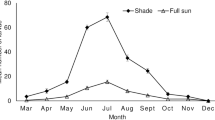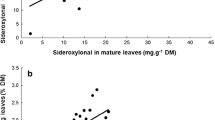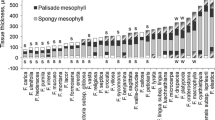Abstract
We examined relative effects of traits of leaf quality of ten willow species (Salix: Salicaceae) on growth rates of five species of insect herbivores found in interior Alaska (a willow sawfly, Nematus calais; the tiger swallowtail butterfly, Papilio canadensis; and three species of chrysomelid beetles, Gonioctena occidentalis, Calligrapha verrucosa, and Chrysomela falsa). Leaf traits examined were water content, toughness, total nitrogen contnet, pubescence, and presence or absence of phenolic glycosides. Of ten Salix species, four species contain phenolic glycosides in their leaves. We examined relative effects of water content, toughness, and nitrogen content of the Salix leaves on larval growth rates at three different levels, i.e., on a single host species, between different host species, and between herbivore species. The within-host analyses showed that effects of water content, toughness and/or nitrogen content on herbivore growth rates were generally significant in early-season herbivores but not in late-season herbivores. For each herbivore species, differences in growth rates between hosts were not explained by differences in water content, toughness, or nitrogen content. The between-herbivore analysis showed that the interspecific difference in larval growth rates were related to difference in water and nitrogen content of the hosts. Pubescence of Salix leaves had little effects on herbivore growth rates. Presence of phenolic glycosides had a positive effects on growth rates of a specialist, N. calais, but no effect on the other specialist, Ch. falsa. Presence of phenolic glycosides had, in general, negative effects on growth rates of nonspecialists, G. occidentalis, C. verrucosa, and P. canadensis.
Similar content being viewed by others
References
Argus GW (1973) The genus Salix in Alaska and the Yukon (Publication in Botany no. 2) National Museum of Canada, Ottawa
Ayres MP (1991) Adaptation and constraint in Papilio canadensis: geographic variation in nutritional physiology and temperature responses. Ph.D. Dissertation, Michigan State University, Lansing, Michigan
Ayres MP, MacLean SF Jr (1987a) Molt as a component of insect development: Galerucella sagittariae (Chrysomelidae) and Epirrita autumnata (Geometridae). Oikos 48:273–279
Ayres MP, MacLean SF Jr (1987b) DEvelopment of birch leaves and the growth energetics of Epirrita autumnata (Geometridae). Ecology 67:558–568
Ayres MP, Suomela J, Maclean JF Jr (1987) Growth performance of Epirrita autumnata (Lepidoptera: Geometridae) on mountain birch: trees, broods, and treexbrood interactions. Oecologia 74:450–457
Ayres MP, Bossart JL, Scriber JM (1991) Variation in the nutritional physiology of tree-feeding swallowtail caterpillars. In: Baranchikov Y, Mattson WJ, Hain FP, Payne TL (eds) Forest insect guilds: patterns of interaction with host trees. USDA For Serv, Northeast For Exp Sta, Gen Tech Rep NE-153: 88–102
Bernays E, Graham M (1988) On the evolution of host specificity in phytophagous arthropods. Ecology 69:886–892
Bryant JP, Clausen TP, Reichardt PB, McCarthy MC, Werner RA (1987) Effect of nitrogen fertilization upon the secondary chemistry and nutritional value of quaking aspen (Populus tremuloides Michx.) leaves for the large aspen tortrix (Choristoneura conflictana (Walker)). Oecologia 73:513–517
Clausen TP, Reichardt PB, Bryant JP, Werner RA, Post K, Frisby K (1989) A chemical model for short-term induction in quaking aspen (Populus tremuloides) foliage against herbivores. J Chem Ecol 15:2335–2346
Denno RF, Larsson S, Olmstead KL (1990) Role of enemy-free space and plant quality in host-plant selection in willow beetles. Ecology 71:124–137
Feeny PP (1968) Effects of oak leaf tannins on larval growth of the winter oak moth Operophtera brumata. J Insect Physiol 14:805–817
Feeny PP (1976) Plant apparency and chemical defense. Rec Adv Phytochem 10:1–40
Fraekel GS (1959) The raison d'être of secondary plant substances. Science 129:1466–1470
Hagen RH, Scriber JM (1991) Systematics of the Papilio glaucus and P. troilus species groups (Lepidoptera: Papilionidae): Inferences from allozymes. Ann Enotomol Soc Am 84:380–395
Hagen RH, Lederhouse RC, Bossart JL, Scriber JM. (1991) Papilio canadensis and P. glaucus (Papilionidae) are distinct species. J Lep Soc 45:245–258
Harvey PH, Pagel MD (1991) The comparative method in evolutionary biology, Oxford University Press, Oxford
Haukioja E (1990) Induction of defenses in trees. Annu Rev Entomol 36:25–42
Haukioja E, Ruohomäki K, Suomela J, Vuorisalo T (1991) Nutritional quality as a defense against herbivores. For Ecol Manage 39:237–245
Hay ME, Duffy JE, Fenical W (1990) Host-plant specialization decreases predation on a marine amphipod: an herbivore in plant's clothing. Ecology 71:733–743
Hultén E (1968) Flora of Alaska and neighboring territories. Stanford University Press, Stanford
Klocke JA, Wageret BV, Lalandrin MF (1986) The ellagitannin geraniin and its hydrolysis products isolated as insect growth inhibitors from semi arid land plant. Phytochemistry 25:85–91
Kearsley MJC, Whitham TG (1992) Guns and butter: a no-cost defense against predation for Chrysomela confluens. Oecologia 92:556–562
Krieger RI, Feeny PP, Wilkinson CF (1971) Detoxification enzymes in the guts of caterpillars: An evolutionary answer to plant defense? Science 172:579–581
Larsson S, Björkman C, Gref R (1986a) Response of Neodiprion sawfly (Hym., Diprionidae) larvae to variation in needle resin acid concentration in Scots pine. Oecologia 70:77–84
Larsson S, Wirén A, Lundgrem L, Ericsson T (1986b) Effect of light and nutrient stress on leaf phenolic chemistry in Salix dasyclados and susceptibility to Galerucella lineola. Oikos 47:205–210
Lederhouse RC, Ayres MP, Nitao JK, Scriber JM (1992) Differential use of lauraceous hosts by swallowtail butterflies, Papilio troilus and P. palamedes (Papilionidae). Oikos 63:244–252
Lincoln DE, Couvet D, Sionit N (1986) Response of an insect herbivore to host plants grown in carbon dioxide enriched atmosphere. Oecologia 69:556–560
Lindroth RL, Bloomer MS (1991) Biochemical ecology of the forest tent caterpillar; response to dietary protein and phenolic glycosides. Oecologia 86:408–413
Lindroth RL, Peterson SS (1988) Effects of plant phenols on performance of southern armyworm larvae. Oecologia 75:185–189
Lindroth RL, Scriber JM, Hsia MTS (1986) Differential responses of tiger swallowtail subspecies to secondary metabolites from tulip tree and quaking aspen. Oecologia 70:13–19
Lindroth RL, Scriber JM, Hsia MTS (1988) Chemical ecology of the tiger swallowtail: mediation of host use by phenolic glycosides. Ecology 63:814–822
Manuwoto S, Scriber JM (1986) Effects of hydrolyzable and condensed tannin on growth and development of two species of polyphagous lepidoptera: Spodoptera cridania and Callosamia promethea. Oecologia 69:225–230
Mattson WJ, Jr (1980) Herbivory in relation to plant nitrogen content. Annu Rev Ecol Syst 11: 19–16
Mattson WJ, Jr., Scriber JM (1986) Nutritional ecology of insect foliovores of woody plants: Nitrogen, water, fiber, and mineral considerations. In: Slansky F Jr, Rodriguez JG (eds) Nutritional ecology of insect, mites, spiders, and related invertebrates. Wiley New York, pp 105–146
McNeil S, Southwood TRE (1978) The role of nitrogen in the development of insect/plant relationships. In: Harbone JB (ed) Biochemical aspects of plant and animal coevolution. Academic Press, London, pp 77–98
McQuate GT, Connor EF (1990a) Insect response to plant water deficits. I. Effect of water deficits in soybean plants on the feeding preference of mexican bean beetle larvae. Ecol Entomol 15:419–431
McQuate GT, Connor EF (1990b) Insect response to plant water deficits II. Effect of water deficits in soybean plants on the growth and survival of mexican bean beetle larvae. Ecol Entomol 15:433–445
Meyer GA, Montogomery ME (1987) Relationships between leat age and the food quality of cotton wood foliage for the gipsy moth, Lymantria dispar. Oecologia 72:527–532
Miles PW, Aspinall D, Correll AT (1982) The performance of two chewing insects on water-stressed food plants in relation to chenges in their chamical composition. Aust J Zool 30:347–355
Miliken GA, Johnson DE (1984) Analysis of messy data, vol. 1. Van Nostrand Reinhold, New York
Neter J, Wasserman W, Kutner MH (1985) Applid linear statistical models, 2nd edn. Irwin, Homewood, Illinois
Neuvonen S, Haukioja E (1984) Low nutritive quality as defense against herbivores: induced responses in birch. Oecologia 63:71–74
Nitao JK, Ayres MP, Lederhouse RC (1991) Larval adaptation to Lauranceae hosts: geographic divergence in the spicebush swallowtail. Ecology 72:1428–1435
Ohmart CP, Stewart LG, Thomas JR (1985) Effects of food quality, particularly nitrogen concentrations, of Eucalyptus blakelyi foliage on the growth of Paropsis atomaria larvae (Coleoptera: Chrysomelidae). Ocologia 65:543–549
Palokangas P, Neuvonen S (1992) Differences between species and instars of Phratora leaf beetles (Coleoptera, Chrysomelidae) in the probability of being preyed on. Ann Zool Fenn 29:273–278
Palokangas P, Neuvonen S, Haapala S (1992) Host plant preference and its effect on growth and defense in two Phratora (Coleoptera: Chrysomelidae) species. In: Menken SBJ, Visser JH, Harrewijn P (eds) Proceedings of the 8th international symposium on insect-plant relationships, Dordrecht. Kluwer Academic, Wageningen, pp 343–345
Pasteels JM, Gregoire J-C (1984) Selective predation on chemically defended chrysomelid larvae: a conditioning process. J Chem Ecol 10:1693–1700
Pasteels JM, Gregoire J-C, Rowell-Rahier M (1983) The chemical ecology of defense in arthropods. Annu Rev Entomol 28:263–289
Pasteels JM, Rowell-Rahier M, Braekman JC, Daloze D (1984) Chemical defences in leaf beetles and their larvae: the ecological evolutionary and taxonomic significance. Biochem Syst Ecol 122:395–406
Price PW, Bouton CE, Gross P, McPherson BA, Thompson JN, Weiss AE (1980) Interactions among three trophic levels: influence of plants on interactions between insect herbivores and natural enemies. Annu Rev Ecol Syst 11:41–65
Price PW, Westoby M, Rice B, Atsatt PR, Fritz RS, Thompson JN, Mobley K (1986) Parasite mediation in ecological interactions. Annu Rev Ecol Syst 17:487–505
Rank NE (1994) Host-plant effects on larval survival of a salicinusing leaf beetle Chrysomela aeneicollis Schaeffer (Coleoptera: Chrysomelidae). Oecologia 97:342–353
Redak RA, Cates RG (1984) Douglas-fir (Pseudotsuga menziesii)-spure budworm (Choristoneura occidentalis) interactions: the effect of nutrition, chemical defense, tissue phenology, and tree physical parameters on budworm success. Oecologia 62:61–67
Reichardt PB, Clausen TP, Bryant JP (1988) Phenol glycosides in plant defense against herbivores. Amer Chem Soc Symp Ser 380:130–142
Reichardt PB, Clausen TP, Bryant JP (1991) Role of phenol glycosides in plant-herbivore interactions. Handb Nat Toxin 6:313–333
Rhoades DF, Cates RG (1976) Toward a general theory of plant antiherbivore chemistry. Rec Ady Phytochem 10:168–213
Roininen H, Tahvanainen J (1989) Host selection and larval performance of two willow-feeding sawflies. Ecology 70:129–136
Rowell-Rahier M (1989) The food plant preferences of Phratora vitellinae (Coleoptera: Chrysomelinae). B. A laboratory comparison of geographically isolated populations and experiments on conditioning. Oecologia 64:375–380
Rowell-Rahier M, Pasteels JM (1982) The significance, of salicin for a Salix-feeder, Phratora vitellinae. In: Vissar JH, Minks AK (eds) Proceedings of the 5th international symposium on insect-plant relationships. Pudoc, Wageningen, pp 73–79
Rowell-Rahier M, Pasteels IM (1986) Economics of chemical defense in Chrysomelinae. J Chem Ecol 12:1189–1203
SAS Institute (1985) SAS User's guide: statistics version 5. SAS Institute Inc, Cary, North Carolina
Schultz JC (1988) Many factors influence the evolution of herbivore diets, but plant chemistry is central. Ecology 69:896–897
Scriber JM (1977) Limiting effects of low leaf-water content on the nitrogen utilization, energy budget and larval growth of Hyalophora cecropia (Lepidoptera: Saturniidae). Oecologia 28:269–287
Scriber JM (1991) Differential suitability of 12 Great Lakes tree species for Papilio canadensis (Lepidoptera: Papilionidae) larval survival and growth. Great Lakes Entomol 24:239–252
Scriber JM, Feeny PP (1979) Growth of herbivorous caterpillars in relation to feeding specialization and to the growth form of their food plants. Ecology 60:829–850
Scriber JM, Slansky F Jr (1981) The nutritional ecology of immature insects. Annu Rev Entomol 26:183–211
Slansky F, Jr, Feeny PP (1977) Stabilization of the rate of nitrogen accumulation by larvae of the cabbage butterfly on wild and cultivated food plants. Ecol Monogr 47:209–228
Smiley JT, Horn JM, Rank NE (1985) Ecological effects of salicin at three trophic levels: new problems from old adaptations. Science 229:649–651
Sokal RR, Rohlf FJ (1981) Blometry 2nd edn. Freeman, New York
Stamp NE, Bowers MD (1990) Phenology of nutritional differences between new and mature leaves and its effect on caterpillar growth. Ecol Entomol 15:447–454
Tahvanainen J, Julkunen-Tiitto R, Kettunen J (1985) Phenolic glycosides govern the food selection pattern of willow feeding leaf beetles. Oecologia 67:52–56
Viereck LA, Little EL Jr (1972) Alaska trees and shrubs. USDA Forest Service, Washington D.C.
Waldbauer GP (1968) The consumption and utilization of food by insects. Adv Insect Physiol 5:229–288
Whittaker RH, Feeny PP (1971) Allelochemics: chemical interactions between species. Science 171:757–770
Wright S (1934) The method of path coefficients. Ann Math Stat 5:161–215
Author information
Authors and Affiliations
Rights and permissions
About this article
Cite this article
Matsuki, M., MacLean, S.F. Effects of different leaf traits on growth rates of insect herbivores on willows. Oecologia 100, 141–152 (1994). https://doi.org/10.1007/BF00317141
Received:
Accepted:
Issue Date:
DOI: https://doi.org/10.1007/BF00317141




